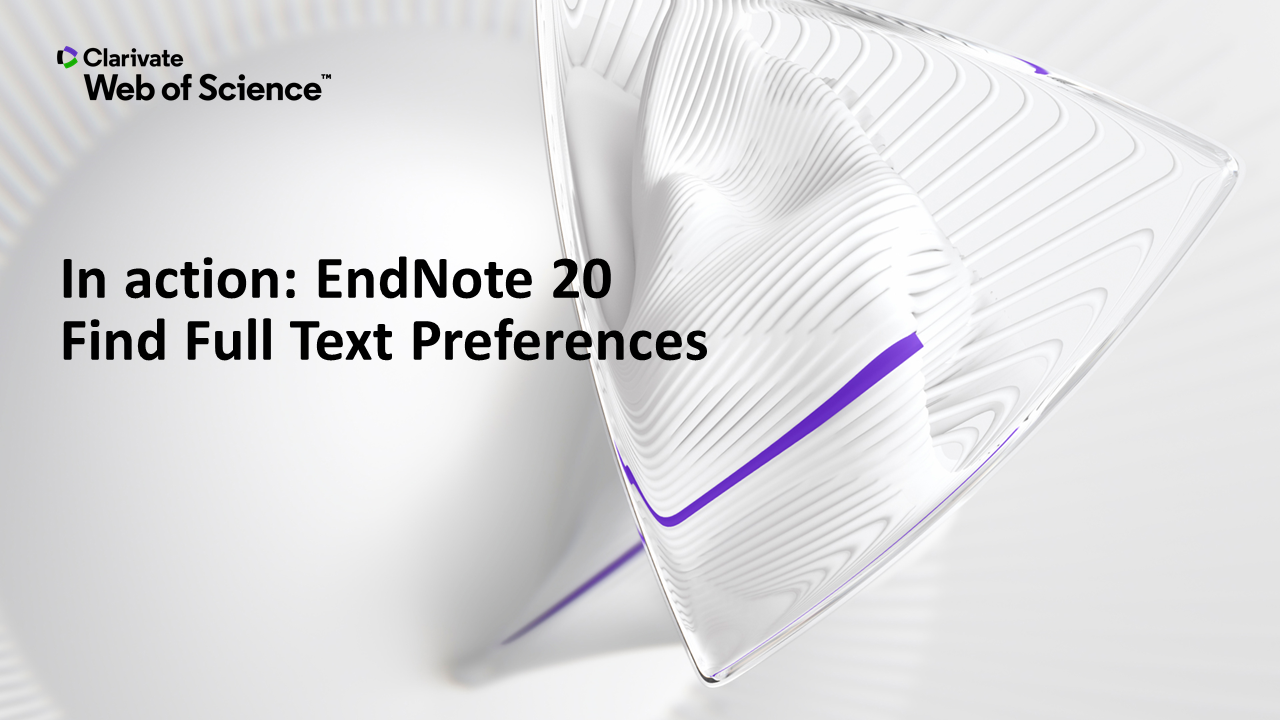EndNote
- About EndNote Toggle Dropdown
- Getting started
- Adding references Toggle Dropdown
- Organising references Toggle Dropdown
- Using EndNote with Word Toggle Dropdown
- EndNote Web
- Syncing your library
- Sharing your library
- Back-up, recover & restore
- After graduating
- Help Toggle Dropdown
- Advanced Tools Toggle Dropdown
Setting preferences in EndNote 20
You can customise features of your EndNote library using Preferences. Select Edit > Preferences from the main menu or click on the cog icon on the right of the EndNote library field headings. On a Mac select Preferences from the EndNote menu to the left of the File menu.
You will notice that all of the preferences panels have the following options:
- EndNote Defaults - Reverts the settings for just the current panel to the original EndNote settings.
- Revert panel - Removes any changes made to the current panel since it was last saved.
- OK - Saves all changes to the preferences and closes the Preferences window.
- Cancel - Discards all changes to the preferences and closes the Preferences window.
- Apply - Activates the changes you made within the panel and keeps the Preferences window open so you can continue editing.
Use the Display Fields preferences to choose which fields to display in EndNote’s Library window. Select the desired field for each column from the Field list. The boxes under Heading displays the text that will appear in your EndNote library headings; this can be altered if you want the headings to display differently to the default settings.
You may select up to 10 fields to be displayed in the Library window. If you want fewer than 10 fields, select [Do not display] instead of a field name.
If you would like to display all author names under the Author heading in the library reference list, select the "Display all authors in the Author field" check box. For all new installations, this is the default setting.
N.B. It can be useful to change the heading of the last column to Record Number - EndNote uses a unique numbering system for all references entered according to numeric order of entry. If you delete a reference and then add it again - it will have a new number (last number in the list). It may be useful to sort by the Record Number field to see the order of the references entered from first reference to the last one.
Video: EndNote 20 Display Fields (0:55)
Note: Processes shown in the video are the same for EndNote 21.
By default, EndNote identifies duplicate references in a library as references of the same Reference Type with matching Author, Year, and Title fields. You can configure your preferences to be more or less specific in searching for duplicates. To select the fields that EndNote should compare when finding duplicate references, click in the check boxes to the left of the field names.
Set the Criteria to have EndNote compare the fields and look for an Exact Match or be less specific in the comparison and Ignore spacing and punctuation.
Video: EndNote 20 Find Duplicates Preferences (0:50) Processes shown in the video are the same for EndNote 21.
**Note - the title displayed in the video below is incorrect. Click on the arrow to start and the correct video will play.**

This feature is used to select what EndNote does when the program is opened. You can choose to have one or more selected EndNote libraries open by default, or display a prompt to select a library to open.
This feature allows you to automatically rename PDFs as they are imported into the EndNote library, by applying a consistent naming convention.
Note that this is not retrospective and will only apply to new PDFs being attached or found through the Find Full Text option. To rename PDFs already attached to references in your EndNote library select the references then from the Main Menu choose - References - File Attachments - Rename PDFs.
Another recommended feature is the PDF Auto Import Folder, which will automatically connect any PDFs you download to the citations in your EndNote library every time you open your library.
This feature allows you to customise the default reference types in your EndNote library. In the EndNote Preferences display, select Reference Types, then click on the Modify Reference Types button. You can modify field names and add new fields to a reference type. These will then be displayed when you add a new reference.
You can also create a new customised reference type by selecting the types labelled Unused (1,2 & 3) from the list.
Create, upgrade and configure your EndNote online account and sync the current library.
When syncing is enabled, the default setting is that EndNote will check the library every 15 minutes to identify changes to send or receive; this can slow down EndNote performance. To turn off automatic syncing, uncheck the Sync Automatically box:
- Last Updated: Oct 10, 2024 2:57 PM
- URL: https://libguides.adelaide.edu.au/endnote
- Print Page









